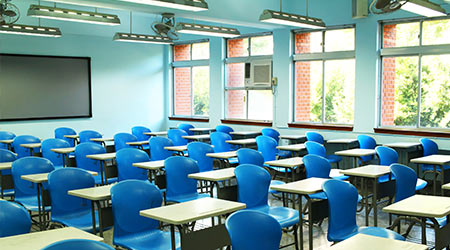
Solar Windows on the Horizon
January 22, 2018
Windows in institutional and commercial facilities sometimes seem like necessary evils. Although occupants demand daylight and views to the outside, windows can lose up to 20 times more energy than the rest of the wall does. Fortunately, significant improvements have been made in window technology and design that allow facility managers to have all the advantages of windows, such as daylight and visibility, while reducing both heating and cooling loads as well as the electricity needed for lighting. And more improvements are on the way in the form of solar-powered glass.
Solar generation is being used in a variety of ways to give managers options on ways want to power their facilities. Instead of large, bulky panels on the roof, there is a more discreet roofing alternative in the form of solar-powered glass, Efficiency has been a problem in the latter, but the National Renewable Energy Laboratory (NREL) has developed a better prototype that is highly adaptable, according to an article in Green Matters.
Read: Smart windows offering facilities more benefits
The new window uses enhanced thermochromic technology, which converts sunlight into usable energy at the highest efficiency we’ve seen yet. According to the research, they saw conversion levels reach 11.3 percent. It only took about three minutes from the window to switch over from a transparent state to a darkened color. When it is dark, molecules are reversibly adsorbed to create electricity.
Efficiency has remained low in glass that can absorb solar energy because most development attempts to put little sacrifice into its transparency. After all, how good is a window if we can’t see anything through it? Many attempts have a static approach, such as Michigan State University creating a glass-like transparent solar material that has five percent efficiency.
Read: A closer look at renewable technologies
The NREL had a different perspective on their solar-powered glass. When it transitions to a darkened color, just 3 percent of sunlight passes through the window. Perovskite solar cells are then activated and generates power. As the sun fades, the window gets cooler, molecules are absorbed back into the product, and it becomes 68 percent clear. Think of transition eyeglasses, which feature photochromic lenses.
It is also a similar take on low heat emission glass (low-E) that is already installed throughout much of the United States. According to the United States Office of Energy Efficiency and Renewable Energy, “80 percent of homes and 50 percent of buildings” in the country feature these windows. NREL’s development just taps into the technology further with thermochromic technology and perovskite material.
“There is a fundamental tradeoff between a good window and a good solar cell,” says Lance Wheeler, a scientist at NREL, in a company news release. “This technology bypasses that. We have a good solar cell when there’s lots of sunshine and we have a good window when there’s not.” The NREL also believes that the product could be expanded to vehicles or on electronics to power them remotely.
This Quick Read was submitted by Dan Hounsell — dan.hounsell@tradepressmedia.com — editor-in-chief of Facility Maintenance Decisions.
Next
Read next on FacilitiesNet












